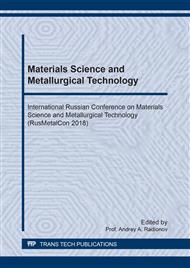[1]
A.I. Akulov, G.A. Belchuk, V.P. Demyantsevich, Technology and equipment of fusion welding, Moscow, Mashinostroenie, (1977).
Google Scholar
[2]
Wen S.W., Hilton P., Farrugia D.C.J., Finite element modeling of a submerged arc welding process, J. of Materials Processing Technology, 119 (2001) 203-209.
DOI: 10.1016/s0924-0136(01)00945-1
Google Scholar
[3]
Mahapatra M.M., Datta G.L., Pradhan B., Mandal N.R., Three-dimensional finite element analysis to predict the effects of SAW process parameters on temperature distribution and angular distortions in single-pass butt joints with top and bottom reinforcements, Int. J. of Pressure Vessels and Piping, 83 (2006) 721-729.
DOI: 10.1016/j.ijpvp.2006.07.011
Google Scholar
[4]
Kiran D.V., Basu B., Shah A.K. et al., Three-dimensional Heat Transfer Analysis of Two Wire Tandem Submerged Arc Welding, ISIJ Int., 51(5) (2011) 793-798.
DOI: 10.2355/isijinternational.51.793
Google Scholar
[5]
Bag S., De A., Development of a Three-Dimensional Heat Transfer Model for the Gas Tungsten Arc Welding Processes Using the Finite Element Method Coupled with a Genetic Algorithm Based Identification of Uncertain Input Parameters, Metallurgical and material transactions A, Vol. 39 A, (2008) 2698−2710.
DOI: 10.1007/s11661-008-9607-1
Google Scholar
[6]
Bibby M., Chakravarti A., Goldak J., A new finite element model for welding heat source, Metallurgical transactions, Vol. 15, (1994).
DOI: 10.1007/bf02667333
Google Scholar
[7]
Divis V. [et al.], Numerical simulation of the welding process distortion and residual stress prediction, heat source model determination, Numerical simulation of the welding process, Vol.49, Issue 11−12, (2005) 15−29.
DOI: 10.1007/bf03266499
Google Scholar
[8]
Mills G.S., Fundamental mechanisms of penetration in GTA welding, Welding J., Vol. 58, No 1, (1979) 21−24.
Google Scholar
[9]
Sidorov V.P., Semistenov D.A., Mathematical modeling of a weld geometry for welding of structural alloys and biometal, Togliatti, Togliatti State University, (2009).
Google Scholar
[10]
Sidorov V.P., Melzitdinova A.V., Determination of permissible deviations of the two-sided arc welding conditions, Welding International, (2016) 1-4.
DOI: 10.1080/09507116.2016.1243748
Google Scholar
[11]
V.V. Frolov, Theory of welding processes, Moscow, Vysshaya shkola, (1988).
Google Scholar
[12]
Andreev S.B., Golovchenko V.S., Gorbach D.V., Russo V.L., Welding fundamentals of seaborne structures, Saint-Petersburg, Sudostroenie, (2006).
Google Scholar
[13]
Sidorov V.P., Semistenov D.A., Khurin S.A., New efficiency factors of metal fusion, Collected papers of All-Russia Conference with international participation Modern problems of efficiency increasing of welding engineering,, Part 1, Togliatti, Togliatti State University, (2006) 128-134.
Google Scholar
[14]
Alekseev Yu.E., Kushnarev L.N., Equipment for arc welding under the flux, Leningrad, Energiya, (1977).
Google Scholar
[15]
Tsvelev R.A. Error estimate of reproduction of temperature field under the welding on flux basing on equivalent heat source, Svarochnoe proizvodstvo [Welding engineering], 6 (2013) 11-15.
DOI: 10.1080/09507116.2013.840034
Google Scholar
[16]
DuPont J.N. Marder A.R., Thermal efficiency of arc welding processes, Welding J, Vol. 74, No 12, 1995, pp.406-416.
Google Scholar
[17]
Erokhin A.A., Fusion welding fundamentals, Moscow, Mashinostroenie, (1973).
Google Scholar
[18]
Dyakonov V.P. Hand book for algorithms and programs on BASIC for personal computers, Moscow, Nauka, (1987).
Google Scholar
[19]
Sidorov V.P., Borisov N.A., Contribution to a product remelting of electrode metal power for welding under the flux, Paika-2013: collected papers of the conference (Togliatti, September 10-12, 2013), Togliatti, Togliatti State University, (2013) 232-239.
DOI: 10.18323/2073-5073-2020-4-34-42
Google Scholar
[20]
Sidorov V.P., Influence of the type and polarity of the current on the penetration of the electrode and base metal for arc welding under flux, Svarka i diagnostika [Welding and diagnostic], 3 (2013) 20-23.
Google Scholar
[21]
Sidorov V.P. The analysis of welding conditions under the flux of double sides joints without edge preparation, IOP Conference Series: Materials Science and Engineering, Vol. 253, Conference 1, (2017).
DOI: 10.1088/1757-899x/253/1/012011
Google Scholar
[22]
Berezovskiy B.M., Stikhin V.A. Calculation of the parameters of the heat flow distribution of the surface welding arc, Svarochnoe proizvodstvo [Welding Engineering], 2 (1980) 1-4.
Google Scholar
[23]
Sidorov V.P., Borisov N.A., The criteria of arc fusion on welding, Svarka i Diagnostika [Welding and Diagnostic], 6 (2013) 24-27.
Google Scholar


